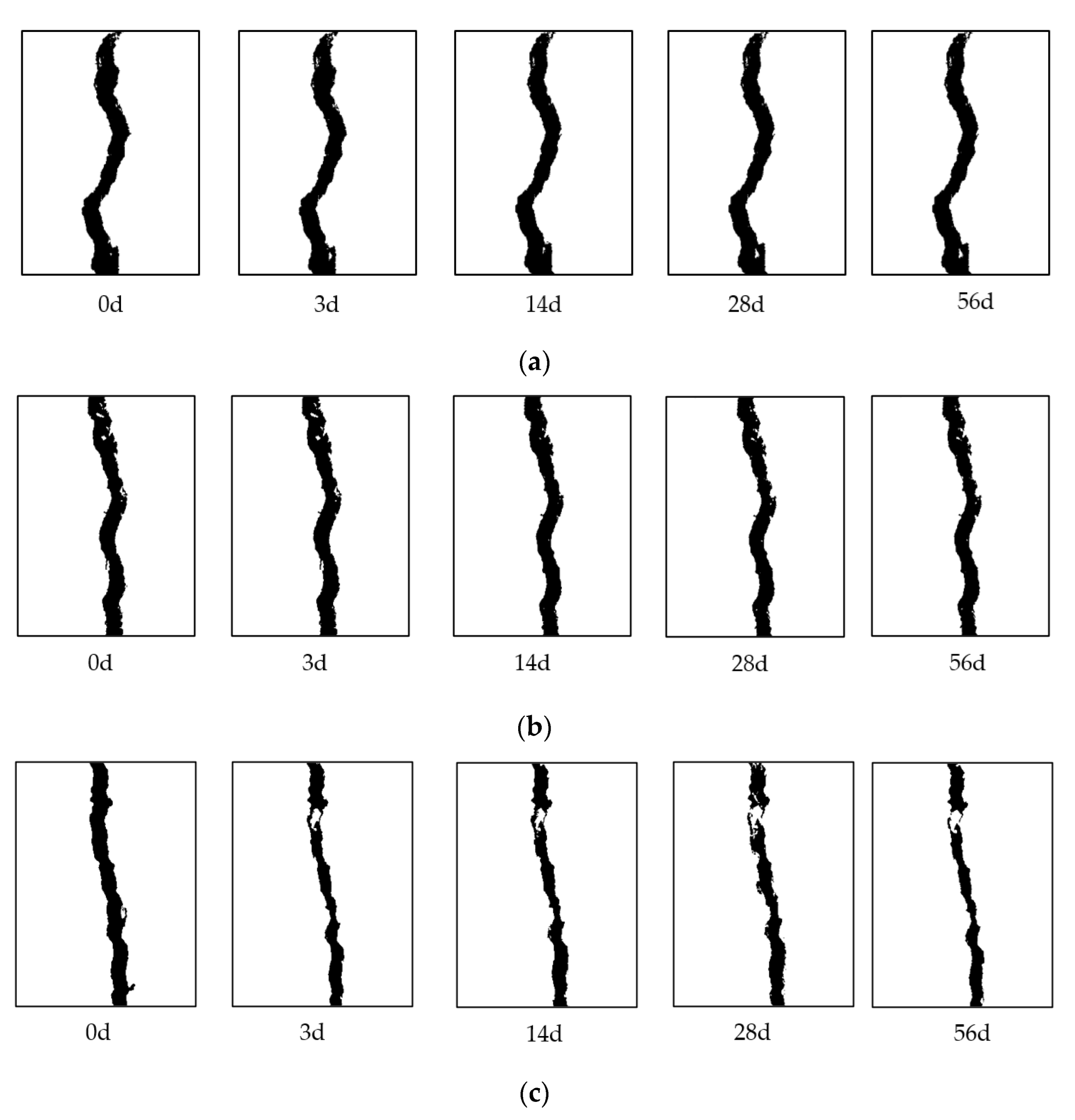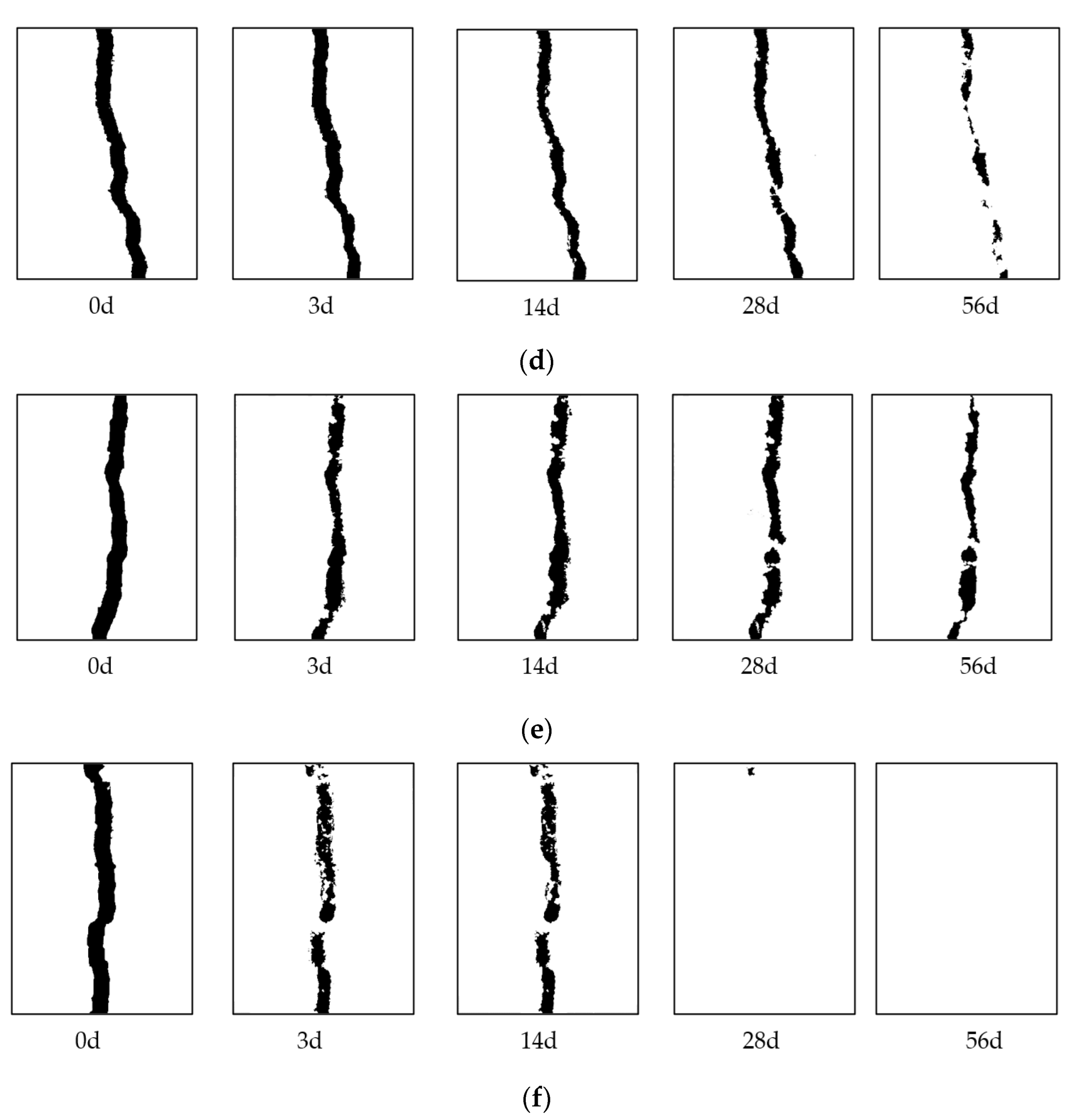Crack Self-Healing of Cement Mortar Containing Ureolytic Bacteria Immobilized in Artificial Functional Carrier under Different Exposure Environments
Abstract
:1. Introduction
2. Materials and Methods
2.1. Bacterial Strain
2.2. Bacteria and Nutrient Immobilization Process
2.3. Preparation of Mortar Specimens
2.4. Methods of Making Cracks
2.5. Exposure Environments
2.6. Evaluation Methods of Self-Repairing Performance
2.6.1. Repair Effect of Crack Surface
2.6.2. The Regain of Water Tightness
2.6.3. Recovery Effect of Mechanical Performance
2.7. Microscopic Investigation
3. Results and Discussion
3.1. Repair Effect of Crack Surface
3.2. The Regain of Water Tightness
3.3. Recovery Effect of Mechanical Performance
3.4. Microscopic Investigation
4. Conclusions
- The mortar specimens based on the artificial-functional-carrier-encapsulated bacteria have a higher crack area repair ratio, and better water tightness regain and recovery ratio of flexural strength compared with the control mortars under the same exposure environment;
- The self-healing effect of mortar cracks with and without bacteria is obviously affected by exposure environments. The presence of water is necessary for crack self-healing. Higher self-healing efficiency is obtained under water curing and dry–wet cycle curing environments;
- The mortar specimens with bacteria generate more repair products in the surface and interior of cracks to greatly improve the self-repair ability of the specimens, which promotes the recovery of water tightness and mechanical performance.
Author Contributions
Funding
Data Availability Statement
Conflicts of Interest
References
- Zhang, W.; Zheng, Q.F.; Ashour, A.; Han, B.G. Self-healing cement concrete composites for resilient infrastructures: A review. Compos. Part B Eng. 2020, 189, 107892. [Google Scholar] [CrossRef]
- Zhang, P.; Wittmann, F.H.; Vogel, M.; Müller, H.S.; Zhao, T. Influence of freeze-thaw cycles on capillary absorption and chloride penetration into concrete. Cem. Concr. Res. 2017, 100, 60–67. [Google Scholar] [CrossRef]
- Peng, J.X.; Hu, S.W.; Zhang, J.R.; Cai, C.S.; Li, L.-Y. Influence of cracks on chloride diffusivity in concrete: A five-phase mesoscale model approach. Constr. Build. Mater. 2018, 197, 587–596. [Google Scholar] [CrossRef]
- Liu, H.; Huang, H.L.; Wu, X.T.; Peng, H.X.; Li, Z.H.; He, J.; Yu, Q.J. Effects of external multi-ions and wet-dry cycles in a marine environment on autogenous self-healing of cracks in cement paste. Cem. Concr. Res. 2019, 120, 198–206. [Google Scholar] [CrossRef]
- Li, W.T.; Dong, B.Q.; Yang, Z.X.; Xu, J.; Chen, Q.; Li, H.X.; Xing, F.; Jiang, Z.W. Recent advances in intrinsic self-healing cementitious materials. Adv. Mater. 2018, 30, 1705679. [Google Scholar] [CrossRef] [PubMed]
- Huang, H.L.; Ye, G.; Damidot, D. Effect of blast furnace slag on self-healing of microcracks in cementitious materials. Cem. Concr. Res. 2014, 60, 68–82. [Google Scholar] [CrossRef]
- Huang, H.L.; Ye, G.; Qian, C.X.; Schlangen, E. Self-healing in cementitious materials: Materials, methods and service conditions. Mater. Des. 2016, 92, 499–511. [Google Scholar] [CrossRef]
- Ramachandran, S.K.; Ramakrishnan, V.; Bang, S.S. Remediation of concrete using micro-organisms. J. Am. Concr. Inst. 2001, 98, 3–9. [Google Scholar]
- Muynck, W.D.; Belie, N.D.; Verstraete, W. Microbial carbonate precipitation in construction materials: A review. Ecol. Eng. 2010, 36, 118–136. [Google Scholar] [CrossRef]
- Wiktor, V.; Jonkers, H.M. Quantification of crack-healing in novel bacteria-based self-healing concrete. Cem. Concr. Compos. 2011, 33, 763–770. [Google Scholar] [CrossRef]
- Jonkers, H.M.; Thijssen, A.; Muyzer, G.; Copuroglu, O.; Schlangen, E. Application of bacteria as self-healing agent for the development of sustainable concrete. Ecol. Eng. 2010, 36, 230–235. [Google Scholar] [CrossRef]
- Wang, J.Y.; Dewanckele, J.; Cnudde, V.; Vlierberghe, S.V.; Verstraete, W.; Belie, N.D. X-ray computed tomography proof of bacterial-based self-healing in concrete. Cem. Concr. Compos. 2014, 53, 289–304. [Google Scholar] [CrossRef]
- Jongvivatsakul, P.; Janprasit, K.; Nuaklong, P.; Pungrasmi, W.; Likitlersuang, S. Investigation of the crack healing performance in mortar using microbially induced calcium carbonate precipitation (MICP) method. Constr. Build. Mater. 2019, 212, 737–744. [Google Scholar] [CrossRef]
- Zheng, T.W.; Su, Y.L.; Zhang, X.; Zhou, H.Y.; Qian, C.X. Effect and mechanism of encapsulation-based spores on self-healing concrete at different curing ages. ACS Appl. Mater. Interfaces 2020, 12, 52415–52432. [Google Scholar] [CrossRef]
- Ruan, S.Q.; Qiu, J.S.; Weng, Y.W.; Yang, Y.; Yang, Y.-H.; Chu, J.; Unluer, C. The use of microbial induced carbonate precipitation in healing cracks within reactive magnesia cement-based blends. Cem. Concr. Res. 2019, 115, 176–188. [Google Scholar] [CrossRef]
- Xu, J.; Wang, X.Z. Self-healing of concrete cracks by use of bacteria-containing low alkali cementitious material. Constr. Build. Mater. 2018, 167, 1–14. [Google Scholar] [CrossRef]
- Su, Y.L.; Zheng, T.W.; Qian, C.X. Application potential of Bacillus megaterium encapsulated by low alkaline sulphoaluminate cement in self-healing concrete. Constr. Build. Mater. 2020, 273, 121740. [Google Scholar] [CrossRef]
- Xu, J.; Wang, X.Z.; Zuo, J.Q.; Liu, X.Y. Self-healing of concrete cracks by ceramsite-loaded microorganisms. Adv. Mater. Sci. Eng. 2018, 2018, 5153041. [Google Scholar] [CrossRef]
- Bundur, Z.B.; Kirisits, M.J.; Ferron, R.D. Use of pre-wetted lightweight fine expanded shale aggregates as internal nutrient reservoirs for microorganisms in bio-mineralized mortar. Cem. Concr. Compos. 2017, 84, 167–174. [Google Scholar] [CrossRef]
- Shaheen, N.; Khushnood, R.A. Bioimmobilized limestone powder for autonomous healing of cementitious systems: A feasibility study. Adv. Mater. Sci. Eng. 2018, 2018, 7049121. [Google Scholar] [CrossRef]
- Wang, J.Y.; Belie, N.D.; Verstraete, W. Diatomaceous earth as a protective vehicle for bacteria applied for self-healing concrete. J. Indus. Microbiol. Biotech. 2011, 39, 567–577. [Google Scholar] [CrossRef] [PubMed]
- Wang, J.Y.; Snoeck, D.; Vlierberghe, S.V.; Verstraete, W.; Belie, N.D. Application of hydrogel encapsulated carbonate precipitating bacteria for approaching a realistic self-healing in concrete. Constr. Build. Mater. 2014, 68, 110–119. [Google Scholar] [CrossRef]
- Wang, J.Y.; Mignon, A.; Trenson, G.; Vlierberghe, S.V.; Boon, N.; Belie, N.D. A chitosan based pH-responsive hydrogel for encapsulation of bacteria for self-sealing concrete. Cem. Concr. Compos. 2018, 93, 309–322. [Google Scholar] [CrossRef]
- Wang, J.Y.; Soens, H.; Verstraete, W.; Belie, N.D. Self-healing concrete by use of microencapsulated bacterial spores. Cem. Concr. Res. 2014, 56, 139–152. [Google Scholar] [CrossRef]
- Intarasoontron, J.; Pungrasmi, W.; Nuaklong, P.; Jongvivatsakul, P.; Likitlersuang, S. Comparing performances of MICP bacterial vegetative cell and microencapsulated bacterial spore methods on concrete crack healing. Constr. Build. Mater. 2021, 302, 124227. [Google Scholar] [CrossRef]
- Zhang, J.G.; Liu, Y.Z.; Feng, T.; Zhou, M.J.; Zhao, L.; Zhou, A.J.; Li, Z. Immobilizing bacteria in expanded perlite for the crack self-healing in concrete. Constr. Build. Mater. 2017, 148, 610–617. [Google Scholar] [CrossRef]
- Liu, C.; Xu, X.Y.; Lv, Z.Y.; Xing, L. Self-healing of concrete cracks by immobilizing microorganisms in recycled aggregate. J. Adv. Concr. Technol. 2020, 18, 168–178. [Google Scholar] [CrossRef]
- Pungrasmi, W.; Intarasoontron, J.; Jongvivatsakul, P.; Likitlersuang, S. Evaluation of microencapsulation techniques for MICP bacterial spores applied in self-healing concrete. Sci. Rep. 2019, 9, 12484. [Google Scholar] [CrossRef]
- Snoeck, D.; Belie, N.D. Repeated autogenous healing in strain-hardening cementitious composites by using superabsorbent polymers. J. Mater. Civil. Eng. 2016, 28, 04015086. [Google Scholar] [CrossRef]
- Luo, M.; Qian, C.X.; Li, R.Y. Factors affecting crack repairing capacity of bacteria-based self-healing concrete. Constr. Build. Mater. 2015, 87, 1–7. [Google Scholar] [CrossRef]
- Roig-Flores, M.; Moscato, S.; Serna, P.; Ferrara, L. Self-healing capability of concrete with crystalline admixtures in different environments. Constr. Build. Mater. 2015, 86, 1–11. [Google Scholar] [CrossRef]
- Nosouhian, F.; Mostofinejad, D.; Hasheminejad, H. Concrete durability improvement in a sulfate environment using bacteria. J. Mater. Civil. Eng. 2016, 28, 04015064. [Google Scholar] [CrossRef]
- Wang, J.Y.; Tittelboom, K.V.; Belie, N.D. Use of silica gel or polyurethane immobilized bacteria for self-healing concrete. Constr. Build. Mater. 2012, 26, 532–540. [Google Scholar] [CrossRef]
- Luo, M.; Bai, J.Q.; Jing, K.; Ding, Z.Q.; Yang, D.Y.; Qian, C.X. Self-healing of early-age cracks in cement mortars with artificial functional aggregates. Constr. Build. Mater. 2021, 272, 121846. [Google Scholar] [CrossRef]













| Mix. | Cement (g) | Sand (g) | Water (g) | AFC (g) | Urea(g) | Calcium Lactate (g) | PP Fiber (g) |
|---|---|---|---|---|---|---|---|
| Control | 450 | 1350 | 225 | / | / | / | 0.7 |
| With bacteria | 450 | 1116 | 225 | 190 | 4.5 | 4.5 | 0.7 |
| Dimensions of Mortar Specimens | Purposes |
|---|---|
| 160 mm × 40 mm × 40 mm | The recovery effect of mechanical performance evaluation. |
| Φ100 mm × 25 mm | Repair effect of crack surface and the regain of water tightness. |
| Φ50 mm × 25 mm | The observation of crack internal healing products. |
Publisher’s Note: MDPI stays neutral with regard to jurisdictional claims in published maps and institutional affiliations. |
© 2022 by the authors. Licensee MDPI, Basel, Switzerland. This article is an open access article distributed under the terms and conditions of the Creative Commons Attribution (CC BY) license (https://creativecommons.org/licenses/by/4.0/).
Share and Cite
Luo, M.; Liu, Y.; Li, X.; Dai, J. Crack Self-Healing of Cement Mortar Containing Ureolytic Bacteria Immobilized in Artificial Functional Carrier under Different Exposure Environments. Buildings 2022, 12, 1348. https://doi.org/10.3390/buildings12091348
Luo M, Liu Y, Li X, Dai J. Crack Self-Healing of Cement Mortar Containing Ureolytic Bacteria Immobilized in Artificial Functional Carrier under Different Exposure Environments. Buildings. 2022; 12(9):1348. https://doi.org/10.3390/buildings12091348
Chicago/Turabian StyleLuo, Mian, Ye Liu, Xu Li, and Junjie Dai. 2022. "Crack Self-Healing of Cement Mortar Containing Ureolytic Bacteria Immobilized in Artificial Functional Carrier under Different Exposure Environments" Buildings 12, no. 9: 1348. https://doi.org/10.3390/buildings12091348




